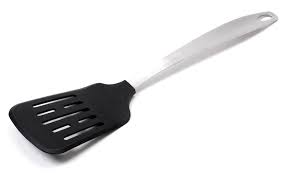Your Cart is Empty
FREE Worldwide Shipping! | +1 365 654 6605
FREE Worldwide Shipping! | +1 365 654 6605
March 01, 2024 3 min read

When it comes to quintessential kitchen tools, the humble spatula holds a special place. This seemingly simple utensil has a fascinating history, a plethora of uses, and a design that's often overlooked: the presence of holes. These seemingly insignificant perforations serve a much more significant purpose than one might initially think. Whether you're an amateur cook or a professional chef, understanding why spatulas have holes can help you utilize this tool to its fullest potential. The term "spatula" has roots dating back to the Roman Empire, with its etymology stemming from the Latin word "spathe," meaning a broad-bladed sword. Over the centuries, these tools have evolved from being weapons to becoming indispensable implements in modern kitchens. Today, spatulas are broadly defined as any cooking implement with a long handle and thin flexible blade. The primary function of the holes in spatulas is to facilitate the drainage of liquids or oils when cooking. The perforations allow excess grease or fat to drain back into the pan, leaving the dish less oily and more balanced. This feature is particularly beneficial when flipping items like burgers or pancakes. Moreover, slotted spatulas also reduce surface tension, making it easier to handle delicate foods. The slots provide less surface area for the food to adhere to, reducing the risk of sticking and improving the overall release of the cooked item. Perforated spatulas feature small holes throughout their surface, making them ideal for cooking greasy or wet foods. On the other hand, slotted spatulas have a dual purpose—they facilitate the drainage of excess liquids and handle delicate food items more efficiently. Turners, a subtype of spatulas, are designed to flip and turn foods. Perforated turners, with their tiny holes, are particularly useful for grilling meats. Slotted turners, on the other hand, are designed for turning delicate food items. Spatulas are available in various materials such as metal, plastic, and silicone. Each material offers its own advantages and disadvantages. For instance, due to their high heat tolerance, metal spatulas are ideal for high-temperature jobs like grilling. However, plastic spatulas, while effective, can melt at high temperatures. Silicone spatulas offer a balance of durability and flexibility. Wooden spatulas, due to their added thickness, are typically not ideal for flipping but are better suited to tasks like stirring. When selecting a spatula, consider its intended use, material, handle length, ease of cleaning, and the quality and durability. For instance, longer handles are beneficial for tasks that require reaching into deep pots or pans, while shorter handles provide better control for precise movements. Be mindful of the heat resistance of your spatula. Plastic or silicone-coated spatulas are ideal for nonstick pans, but caution should be exercised as plastic spatulas can melt at high temperatures. Check your spatulas regularly for signs of wear, such as cracks, loose handles, or frayed edges. Damaged spatulas should be replaced to prevent potential hazards during cooking. A spatula may seem like a simple kitchen tool, but its versatility and importance cannot be underestimated. Understanding the different types of spatulas and their uses will help you make informed decisions when choosing the right ones for your cooking needs.1. The Evolution of Spatulas
1.1 From Swords to Kitchen Tools
2. The Purpose of Holes in Spatulas
2.1 Functional Significance
2.2 Reducing Surface Tension
3. Types of Spatulas with Holes
3.1 Perforated and Slotted Spatulas
3.2 Perforated and Slotted Turners
4. Material Choices for Spatulas
4.1 Metal, Plastic, and Silicone Spatulas
4.2 Wooden Spatulas
5. Choosing the Right Spatula
5.1 Factors to Consider
6. Spatula Safety and Maintenance
6.1 Avoid High Heat
6.2 Regular Inspection
7. Conclusion
References
Be the first to know about upcoming sales and promos. Get a 10% discount coupon when you subscribe!